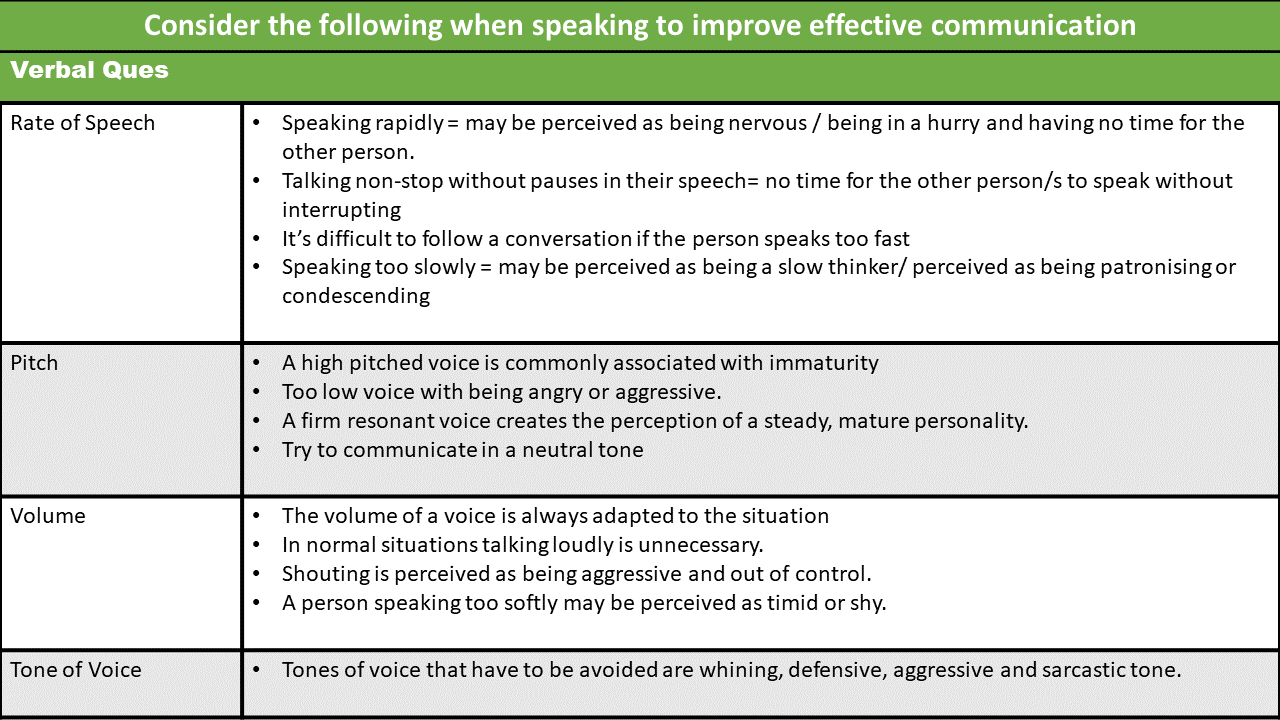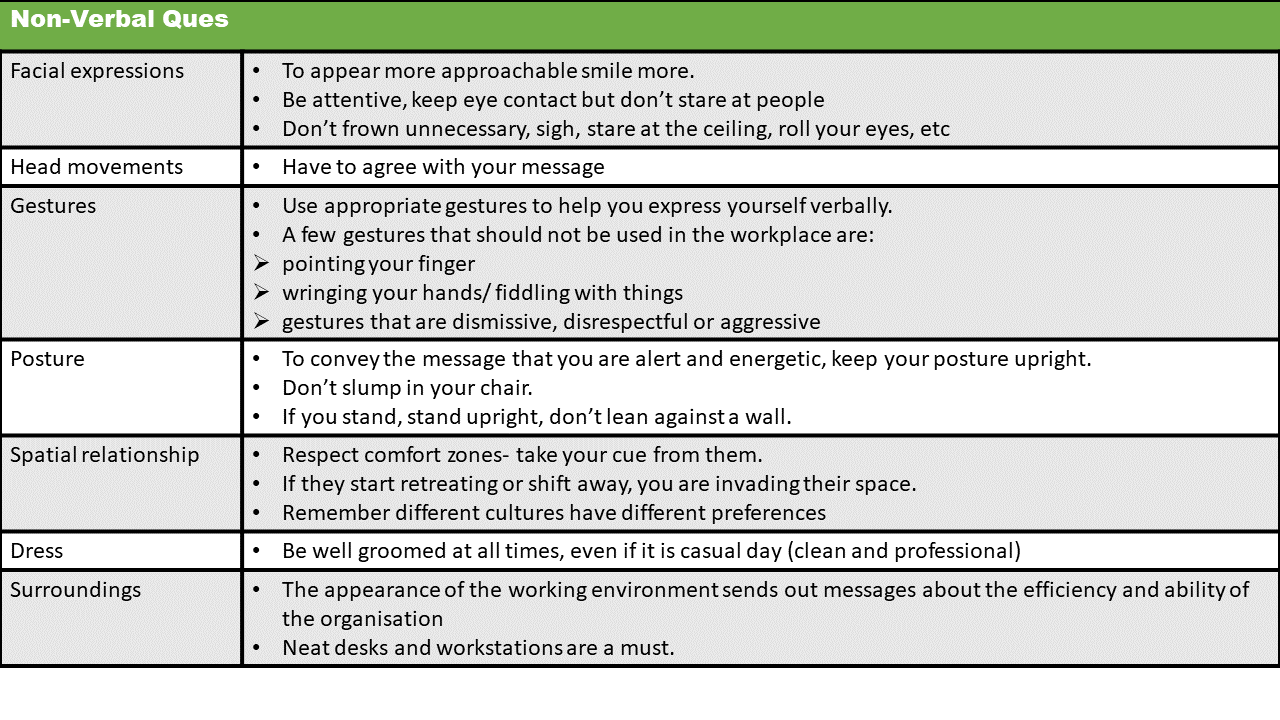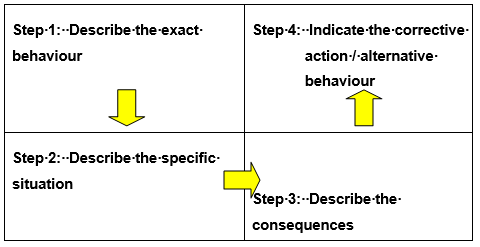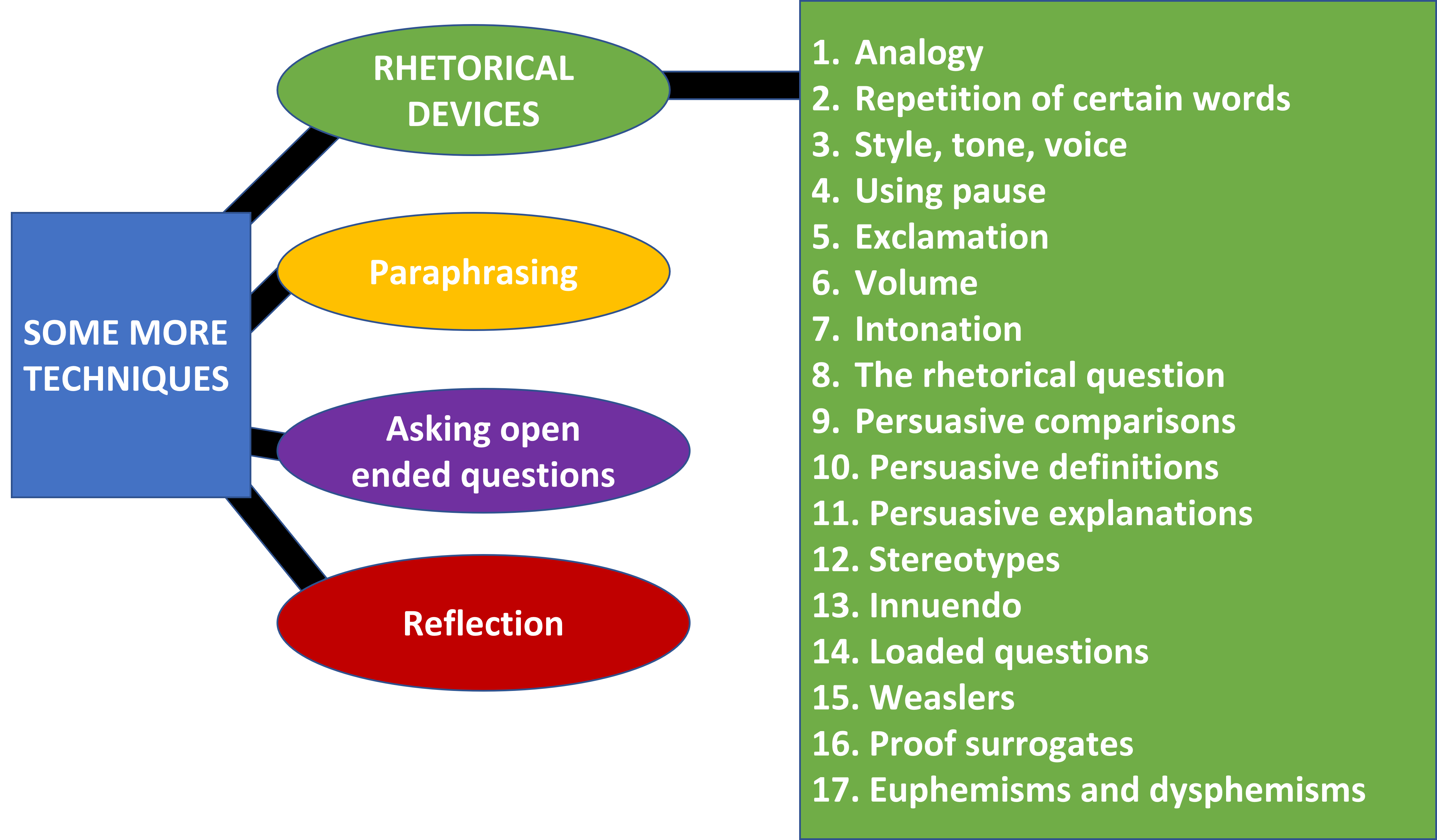Management is the process of producing results through other people. The manager’s primary focus is no longer on him and the tasks he has to perform, but on the employees who do the tasks. His success depends to a large extent on how he and the employees work together to accomplish goals. As a worker, he possibly performed the tasks better than other employees and was therefore promoted to the position of manager. Now he doesn’t do the same tasks anymore but oversees the performance of others who do them.
Management requires a different mindset. The manager has to direct, coach, monitor and report in order to accomplish the desired results.

The effectiveness of the manager resides in his relational skills. To be effective he needs to be a skilful communicator – especially in interpersonal communications. The following communication techniques are essential in interpersonal communication:
Listening Skills
Listening is perhaps managers’ or supervisors’ greatest tool for improving performance, assisting employees and identifying and fixing problems. Many problems in the workplace are created and then continued because of poor listening practices.
There is a huge difference between hearing and listening. Hearing is the physical ability to perceive sounds that is transmitted or spoken. Sounds travel through the hearing system via the outer ear, middle ear, inner ear and the auditory nerve to the brain. If a person does not have a hearing loss he is able to perceive environmental and speech sounds in the auditory area in the brain. Conscious perception of what is being heard does not need to take place. Listening, on the other hand, is a complex active, mental process. Listening is a much neglected communication skill. With practice a poor listener can improve his listening skills and become an effective listener.
There are five stages in the actual listening process:

Stage One – Hearing: Sounds are perceived by the listener but conscious perception does not need to take place.
Stage Two – Attention: The listener focuses on what is being said and how it is being said.
Stage Three – Understanding: The content of the message is analysed and interpreted so that understanding takes place. Because of the role of frame of reference and perception the perceived message differs from person to person.
Stage Four – Remembering: The message is stored for later recall or reference.
Stage Five – Responding: The listener responds to the speaker and the speaker can see if the listener understood the message correctly.
Barriers to Effective Listening
Poor listeners often experience the following difficulties:
Distraction: The poor listener’s attention is easily distracted by the environment e.g. noise, visual distractions, someone walking past, a person’s jewels or clothes.
Bias: Assumptions are made about what the speaker is going to say. The listener makes his mind up in favour or against the argument beforehand and does not listen to the message of the speaker.
Understanding and interpreting the message: When a listener focuses too much on individual words or nonverbal codes or the pronunciation of the speaker, the message may be lost in the process. Listening is even more important in effective communication than verbal or written communication skills. A good listener is often perceived as being a very good communicator even if he/she didn’t say much during a conversation. Effective listeners are aware of their listening habits and distinguish between deliberate and emphatic listening.
Deliberate listening involves an active process where the listener seeks to understand and analyse information e.g. receiving instructions, or listening to a lecture.
Emphatic listening involves listening to understand the feelings of the speaker.
Consider the following when speaking to improve effective communication:


Responding Through Feedback
Positive vs Negative Feedback:
Positive feedback is more readily and accurately perceived than negative feedback. Furthermore, while positive feedback is almost always accepted, the negative variety often meets resistance. Why? The logical answer seems to be that people want to hear good news and block out the bad. Positive feedback fits what most people wish to hear and already believe about themselves.
Does this mean that you should avoid giving negative feedback? No!

Feedback Model
Paul J Jerome, in his book “Coaching through effective feedback” shares a model that can be effectively applied to give positive feedback, negative feedback and neutral feedback in a constructive manner.

Step 1 - Describe the current behaviour: Describe the current behaviour that you want to reinforce or redirect to improve the situation or the performance of the individual. Be very specific. Focus on behaviour and not personality, attitude or characteristics.
Step 2 - Identify the situation: Identify the specific situation where you observed this behaviour. Be factual, give date and time if required or describe the event.
Step 3 - Describe the impact of the consequences of the behaviour: Describe the impact or consequences of the behaviour to the person. Be precise and objective. Include the consequences for the business/job/organization as well as the consequences for the individual/ person.
Step 4 - Identify alternative behaviour/Corrective action: Discuss alternative behaviour that the person can consider for future purposes. Also consider what corrective action should be taken to rectify or improve the current situation/consequences.
Click here to video a video that explains how to use the SBI feedback model.
Constructive Disagreement
Mention the word “conflict” and most people think of fights, riots or war. In fact, on just about every day of every year, one can find approximately two dozen armed combat situations somewhere in the world. But these extreme situations represent only the most violent expressions of conflict. During a typical meeting, you may encounter more subtle and non-violent types of conflict such as arguments, criticism and disagreement.
If you don’t like the idea, say so in a way that does not close down the conversation but, rather provides a way to keep it going. This has three elements.
Like What I do like about your suggestion is…
But What I have a problem with, however, is…
Move on How would it work if…?
Example:
A lot of changes have taken place in your office. New equipment is coming in and space is at a premium. Bob has an idea about where to put a computer printer. He says: Why don’t we put the printer in the training room? This place is getting too cramped to work in.
Jaco replies: What I like about your idea is that it gives us some more useable office space. What I have a problem with is that it won’t be available if someone is using the training room. How would it work if we move some of these filing cabinets, which we don’t use much into the training room and put the printer in their space?
Some More Communication Techniques
Reflection:
Reflecting entails a reasonably accurate rephrasing of the other person’s emotional attitude. Now it is not necessary to state your observation explicitly but your statement should nonetheless be based on something the person said or indicated.
Do not use reflection to judge. Reflection will enable you to test for underlying feelings.
Typical reflection will start with:
“It seems to me…”
Asking Open Ended Questions:
The best way to double-check your understanding of what a source has said is to ask questions in order to clarify and amplify. Ask the person to repeat or rephrase his remarks.
Ask for additional information to amplify a point. Keep your questions polite and to the point.
Open-ended questions assist in further exploration of what was said. It will help you to gain a better understanding of the situation.
Open-ended questions typically will start with:
How…
What…
Tell me about…
Please explain…
Paraphrasing
A technique to help you to check if you understood what was said. If you want to check if you understood clearly, you can shortly summarise what you heard and then as “Is that what you meant?”
Paraphrasing will typically start with:
“What I hear you saying is...”
Rhetorical Devices
In the English Language there are an array of tools that can be used to improve your communication, make it more colourful or even to manipulate your audience/readers into believing the unbelievable. These are called rhetorical devices. Some of these techniques include:
Analogy: The comparison of two pairs that have the same relationship. The key is to ascertain the relationship between the first so you can choose the correct second pair. Part to whole, opposites, and results of, are types of relationships you should find. An example a partial similarity, as the computer is like the brain.
Repetition of certain words: Repetition may be used to emphasise a point and to ensure that the point is clearly carried across.
Style, tone, voice: Gut reactions are useful here. Examine your own responses. What is it that makes you respond as you do? Are you the author’s intended audience? If not, who is? The attitude a writer takes towards a subject or character: serious, humorous, sarcastic, ironic, satirical, tongue-in-cheek, solemn, objective.
Using pause: A pause may be used for effect to gain the audience’s attention.
Exclamation: An exclamation is to cry out or speak suddenly and excitedly. This is a technique to catch the audience’s attention.
Volume: Ensure that you are speaking loudly and clearly. Varying the volume and speed at which you speak can also generate interest.
Intonation: Vary the pitch of your speaking. It is very difficult to listen to a speaker who is conducting his communication in a monotone.
The rhetorical question: A question where an answer is not expected; often used to involve the audience and create interest. The person who asks, "What kind of stupid plan is that?" expects no answer.
Persuasive comparisons: Affecting an opinion by making a comparison with a negative influence. An example is "her hair is the colour of dirty, copper wire".
Persuasive definitions: Affecting an opinion by defining a key term in such a way that we are led to the speaker's conclusion. An example is "capital punishment is socially sanctioned murder".
Persuasive explanations: Affecting an opinion by explaining a key concept or point in such a way that we are led to the speaker's conclusion. An example is "health care has deteriorated because the government is full of incompetent bureaucrats".
Stereotypes: Speakers often group people together under an inappropriate stereotype to affect our thinking on some issue. In this context, stereotypes are based on generalisations which may or may not be true (in general), for example people’s character traits. The problem comes when the generalisation is applied in a situation where we need to make a judgement on a case-by-case basis. An example may be "rejecting a young woman candidate for a job on the grounds that 'all young women want to start a family".
Innuendo: Innuendoes rely on the implied messages sentences often carry with them. As an example after a dinner party, "Was the dessert good?" "Well, I managed to get through it."
Loaded questions: Forcing someone to answer in such a way that they lead the audience to an inappropriately implied message. An example is "in a court case, a lawyer asking a man to give either "yes" or "no" to the question "Have you stopped beating your wife?"
Weaslers: Constructing a claim in such a way that even though it is true, it suggests something quite different from what would be concluded if all the information was made explicit. This is very common in advertising. An example is “Up to 60% off" (which may mean 60% off one item, 5% off everything else) or “The most powerful car in its class" (where the class has been specially defined and it's the only one in it).
Proof surrogates: Suggesting that there is proof for a claim without actually giving it or saying where the audience might find it. As an example beware of phrases such as "Many experts believe that…” and "Leading medical practitioners recommend…"
Euphemisms and dysphemisms: A euphemism is a word that is thought to have no negative connotations associated with it that is used in the place of one that does have negative or hurtful connotations. A dysphemism is the opposite of a euphemism. Examples are "Differently abled" vs. "Handicapped" and "Collateral damage" vs. "Civilian deaths".
When thinking critically about some claim presented to us, it is important to be aware when our thinking may be being influenced by the use of rhetorical devices. Many of these rhetorical devices are fairly obvious. We are so frequently exposed to them, often in advertising and the media.
